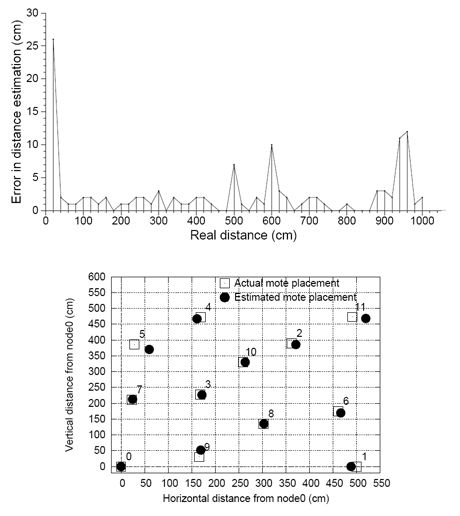by Evangelos Mangas and Angelos Bilas
Sensor localization is an important component and enabler of many applications using intelligent sensors. FLASH is a system that achieves fine-grained localization using acoustic sounds and high-precision clock synchronization via radio frequency (RF) communication. Sensors can dynamically localize themselves in space by maintaining synchronized clocks and measuring time of arrival for acoustic sound pulses. Our techniques focus on achieving highly accurate synchronization and consistent sound detection. Furthermore, FLASH does not require external infrastructure such as fixed equipment, specialized hardware support, or great resource consumption. Experimental results show that FLASH localization is accurate to within 11cm in a variety of indoor environments.
Localization is an important component of many sensor applications. For instance, the ability to accurately locate humans or objects in enclosed spaces can help in detecting and responding to abnormal situations. Techniques such as the use of GPS, image processing or static ranging mechanisms are either not effective, cumbersome to use, or incur high costs.
Our work focuses on achieving fine-grained localization without excessive or specialized resources that use wireless sensor nodes. We rule out the use of extensive external infrastructure, since it is usually both expensive to acquire and complex to install. Moreover, it is important to achieve localization by using only typical resources available in sensor nodes, without the use of specialized hardware peripherals. For these reasons, we choose an approach that relies on an acoustic sound-ranging scheme. Each reference node produces an audible sound pulse while the rest of the nodes are sensing the audio frequency spectrum. All listening nodes attach a timestamp to the received sound pulse, in a global synchronized timescale. These (synchronized clock) timestamps are used to calculate the time of flight for each sound pulse. Distance is then estimated based on the speed of sound. Our work is therefore focused on high-accuracy clock synchronization and sound detection for range estimation.
To achieve precise clock synchronization we implement a synchronization protocol operating at the Media Access Control (MAC)-Layer that does not introduce significant communication costs and that deals with fixed overheads introduced by the interrupt mechanism and RF communication. We also introduce an external mechanism for testing synchronization precision, causing simultaneous interruptions to synchronizing motes and then comparing the synchronized timestamps produced. We implement our synchronization protocol on Mica2dot motes. Our experimental results show that synchronization precision has an error of less than 5µs (median) for a 30s resynchronization period.
Our acoustic sound technique focuses on consistently detecting the start of the arriving sound pulse. Attaching a timestamp at the beeper node is simple: right before applying voltage to the embedded buzzer we use the local (synchronized) clock to broadcast an RF message. At each listening node we identify a sound pulse produced by the beeper node by using the periodicity of the sound pulse and requiring the average peak-to-peak amplitude to surpass a certain predefined dynamic threshold, which is less susceptible to reflections. Then we attach a timestamp to the first peak-to-peak measurement that was of greater value than our dynamic threshold. The difference between the two timestamps at the beeper node and the listening node results in the time of flight for the sound pulse.

Overall, FLASH demonstrates that localization can be achieved with inexpensive off-the-shelf devices and yet be quite precise. Figure 1 shows part of our experimental setup, whereas Figure 2 shows our results for 1D and 2D localization. Using the Berkeley Mica2dot motes, the default microphone that already exists on the sensor platform and cheap simple buzzers, we were able to locate nodes at distances of up to 10m, depending on surrounding noise. The average error in localization precision is 11cm for distances up to 7m. However, our approach does not require either calibration or any special infrastructure. Furthermore, our method requires a single sounder and microphone per node, resulting in better energy efficiency compared to methods that use multiple sensor devices per node.

Future work in the area includes localization in outdoor and more demanding environments, such as in the presence of obstacles between nodes, intense noise in a room, temperature and humidity variations and outdoor environments. We believe that FLASH and similar techniques will play an important role in cyber-physical systems and in our efforts to better interact with and control our environment.
Link:
http://www.ics.forth.gr/carv/scalable/
Please contact:
Angelos Bilas
ICS-FORTH, Greece
E-mail: bilas![]() ics.forth.gr
ics.forth.gr
http://www.ics.forth.gr/~bilas










